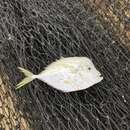Diagnostic Description
provided by Fishbase
Body very short, deep, and compressed; lower branch of first gill arch with 30 to 35 gill rakers; dorsal fin with 8 spines followed by another spine and 21 to 24 soft rays (VIII1, 21-24); anterior lobe of second dorsal and anal fins not elongated in adults; anterior dorsal spines prolonged in juveniles; body scaleless; lateral line scutes very weak and poorly differentiated; body silvery to gold with metallic blue highlights; juveniles silvery, with a dark oval stain on the straight part of the lateral line (ref. 55763).
Trophic Strategy
provided by Fishbase
Marine-stenohaline (Ref. 121811). A pelagic and demersal species found in coastal waters up to at least 50 m depth (Ref. 9283). Also found in an estuary (Ref. 121811). Juveniles are encountered near the surface (Ref. 9283). Feeds on small fishes and crustaceans (Ref. 9283). Piscivore (Ref. 57615).
Biology
provided by Fishbase
Adults are found in coastal waters up to at least 50 m depth (Ref. 9283). They generally form schools near the bottom (Ref. 9283). Juveniles are encountered near the surface (Ref. 9283). They feed on small fishes and crustaceans (Ref. 9283). Marketed fresh and salted or dried (Ref. 9283).
Importance
provided by Fishbase
fisheries: minor commercial; price category: medium; price reliability: very questionable: based on ex-vessel price for species in this family
Selene peruviana: Brief Summary
provided by wikipedia EN
Selene peruviana, the Peruvian moonfish or Pacific moonfish, is a species of jack in the family Carangidae. It is found in the eastern Pacific Ocean.
- license
- cc-by-sa-3.0
- copyright
- Wikipedia authors and editors

